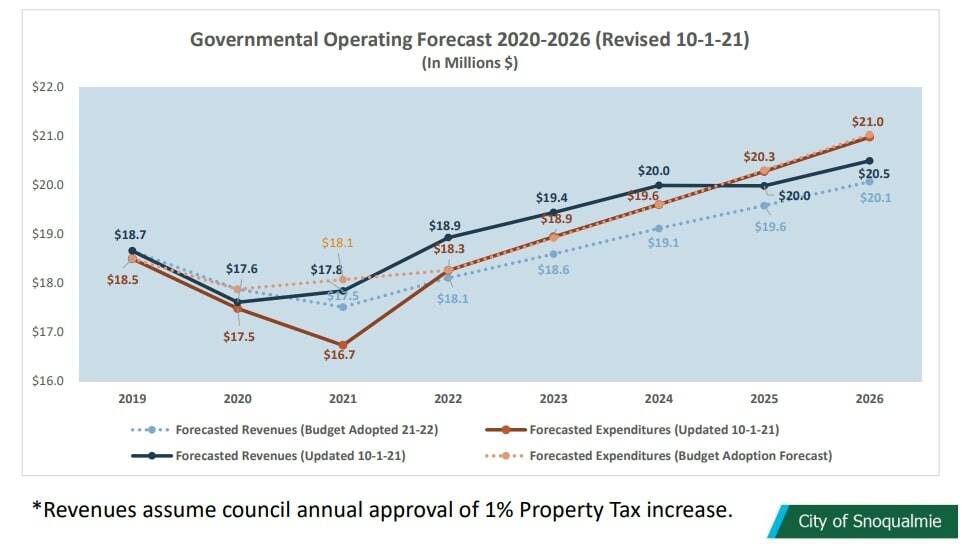Despite financial difficulties caused by the pandemic, the City of Snoqualmie has continued to avoid a revenue shortfall, according to its mid-biennial budget review.
The mid-biennial review looks at the city’s general government operating budget, which includes funding for finance and administration, streets, parks and community development.
The city’s 2021-2022 biennium budget, which was approved by council in the fall of 2020, made significant budget cuts in anticipation of the lasting impacts caused by the pandemic. Budget cuts have allowed the city to avoid a revenue shortfall so far, but with an expected increase in expenditures, the city is projected to see a budget deficit by 2025.
“Recovery from COVID is still underway,” said Robert Hamud, the city’s finance director. “We are strengthening our revenues coming out of it, but we are obviously still feeling its effects.”
Between 2019 and 2020, the city’s revenue dropped by $1.1 million. In 2020, the city’s expenditures finished just $100,000 below revenues. In anticipation of a $600,000 projected revenue shortfall in 2021, the city issued a hiring and new initiative freeze. The city also took on large reductions in services.
Prior to the pandemic, the city had already been facing significant revenue difficulties, with both the cancellation of the Salish Lodge Expansion Project and conclusion of the Snoqualmie Ridge Buildout.
However, despite initial predictions, revenues rebounded slightly in 2021, rising by $200,000 from 2020. As a result of its precautions, the city created almost a million-dollar revenue surplus.
“This past year was very difficult and we never had to dip into our reserves as we balanced the budget,” Councilmember Katherine Ross said. “It’s an important takeaway as we continue to balance the budget as we have in all previous years.”
In an Oct. 5 memorandum, Hamud said that the city is still recovering from revenue losses due to the pandemic, but the future financial outlook has improved in 2021. The city projects revenues and expenditures to return to pre-pandemic levels by 2022.
Hamud attributed the rebound to increases in funds from taxes as well as a large number of vacant positions in city staff. As of Oct. 19, 15% of city staff positions remain vacant. Although this helped the city financially recover in the short term, it is not sustainable.
“The current level of vacancies within the city is unsustainable due to a noticeable drop in service level,” Hamud wrote. “Expenditures will have to increase in future years to close the gap in vaccines as well as restore service levels.”
The city faces some expenditure uncertainty going forward due to labor and inflationary costs, Hamud said. The city has concerns regarding ongoing labor negotiations among the city’s three labor unions and a need for maintenance among streets, parks and other facilities.
In order for the city to meet its revenue projections, Hamud said the council needs to approve an annual 1% increase in property tax. Otherwise, the city’s property tax will stagnate, with the only property taxes coming from construction.
“The city is built out,” he said. “So property taxes won’t grow.”
Based on October projections, the city is expecting to see a revenue deficit in its general fund of $300,000 by 2025 and a $500,000 shortfall by 2026. This occurs at the same time as the city’s American Rescue Plan Act (ARPA) federal funding is set to run out.
The city has received $1.9 million thus far in federal ARPA funds and is anticipating more in the future. Annually, $500,000 of the ARPA funds will be put into the city’s general budget until 2024. Without the federal funding, the city was projected to see a neutral budget by 2023 and a deficit by 2024
“The ARPA funds are critical in keeping the city on solid financial ground,” Hamud said. “If there’s any anticipated drop in revenue or unanticipated expenditures, we have more cushion by not having to get into those reserved funds.”
Councilmember James Mayhew praised the city staff and administration for keeping the city out of financial trouble. He said for a long time the city did not know federal funding was coming, but over the years, the city had built up a reserve that allowed it to avoid a shortfall. He added a future budget shortfall is something the council knew it would have to deal with.
“We thought we were on the brink now, but in just a couple years, we’re facing the same policy challenge,” he said. “Timing has shifted a bit, but we’ve got the same inherent challenge that we’ve had to deal with.”


